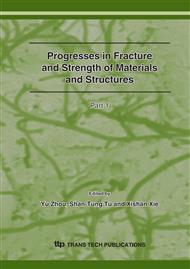p.1045
p.1049
p.1053
p.1057
p.1060
p.1064
p.1068
p.1072
p.1078
Investigating Morphology Evolution of Damage by a Cellular Automaton Modelling
Abstract:
A two-dimensional cellular automaton (CA) model is developed to simulate damage and fracture morphology evolution on the mesoscale in materials. The plastic convection of damage is mapped onto the CA lattice, and initiation, propagation and coalescence of damage are simulated with a local rule-based scheme of a probability cellular automaton. The model includes known physical distinctions of fracture behavior between microcracks and microvoids, and they are characterized by modifying the probability rule of the cellular automaton. The simulations provide visual insight to understand how those physical processes dynamically progress and they affect the damage evolution in materials. The modeling can be used to link micromechanical models to continuum damage models.
Info:
Periodical:
Pages:
1060-1063
Citation:
Online since:
September 2007
Authors:
Price:
Сopyright:
© 2007 Trans Tech Publications Ltd. All Rights Reserved
Share:
Citation:


